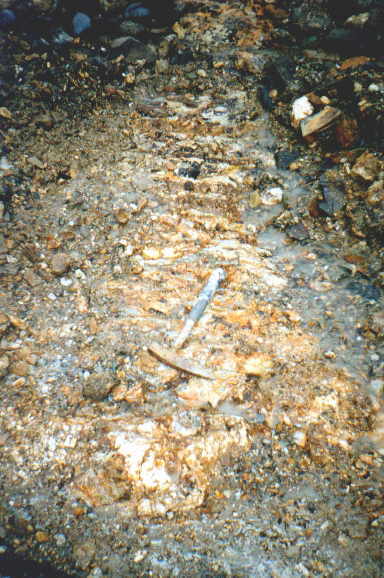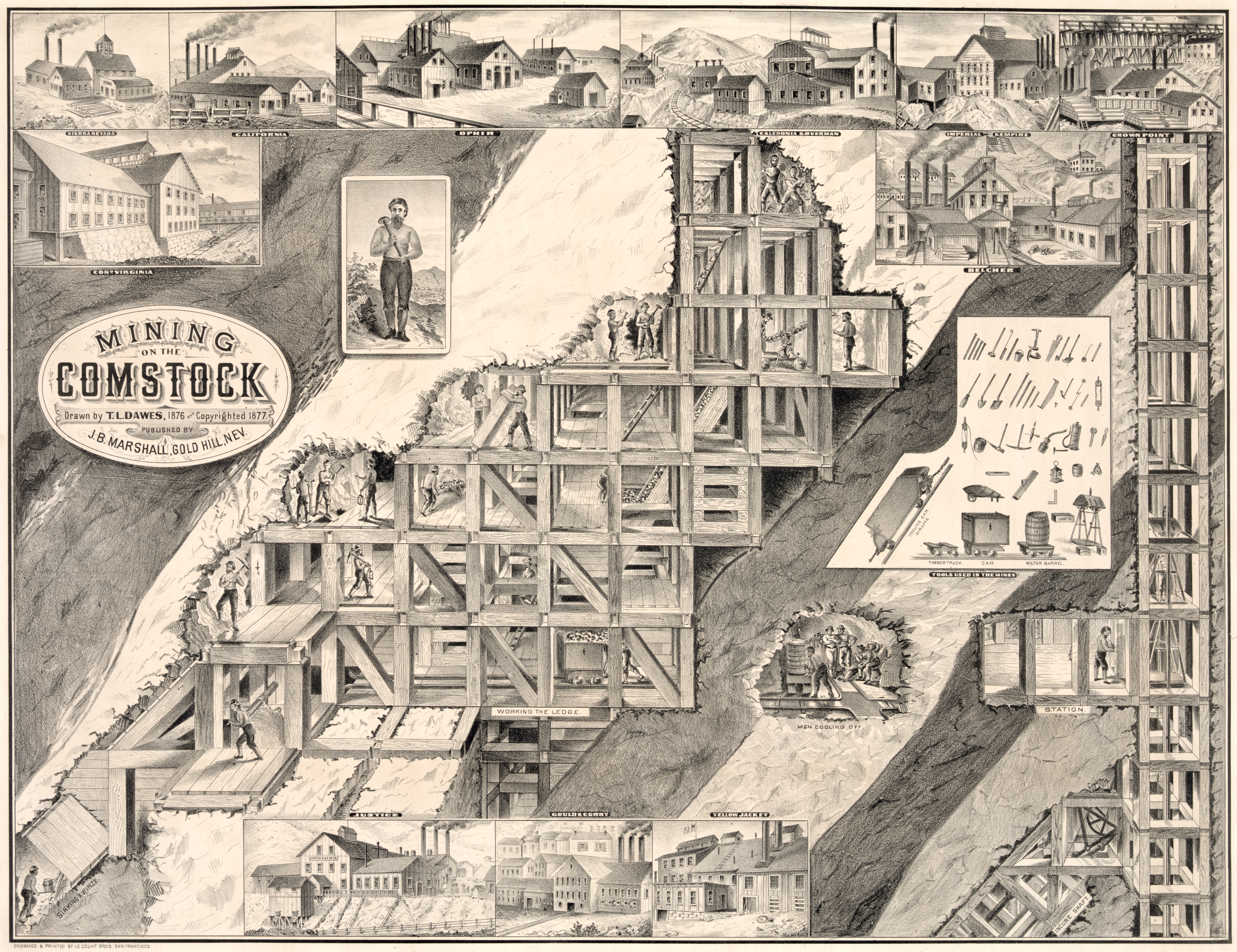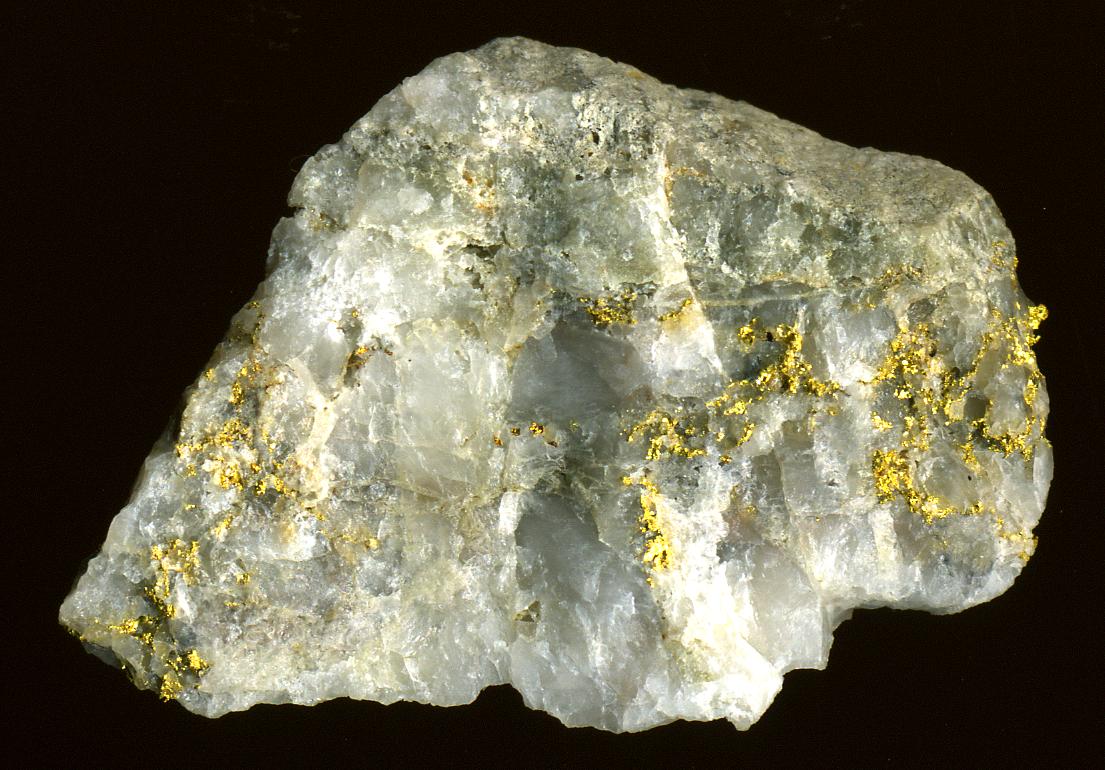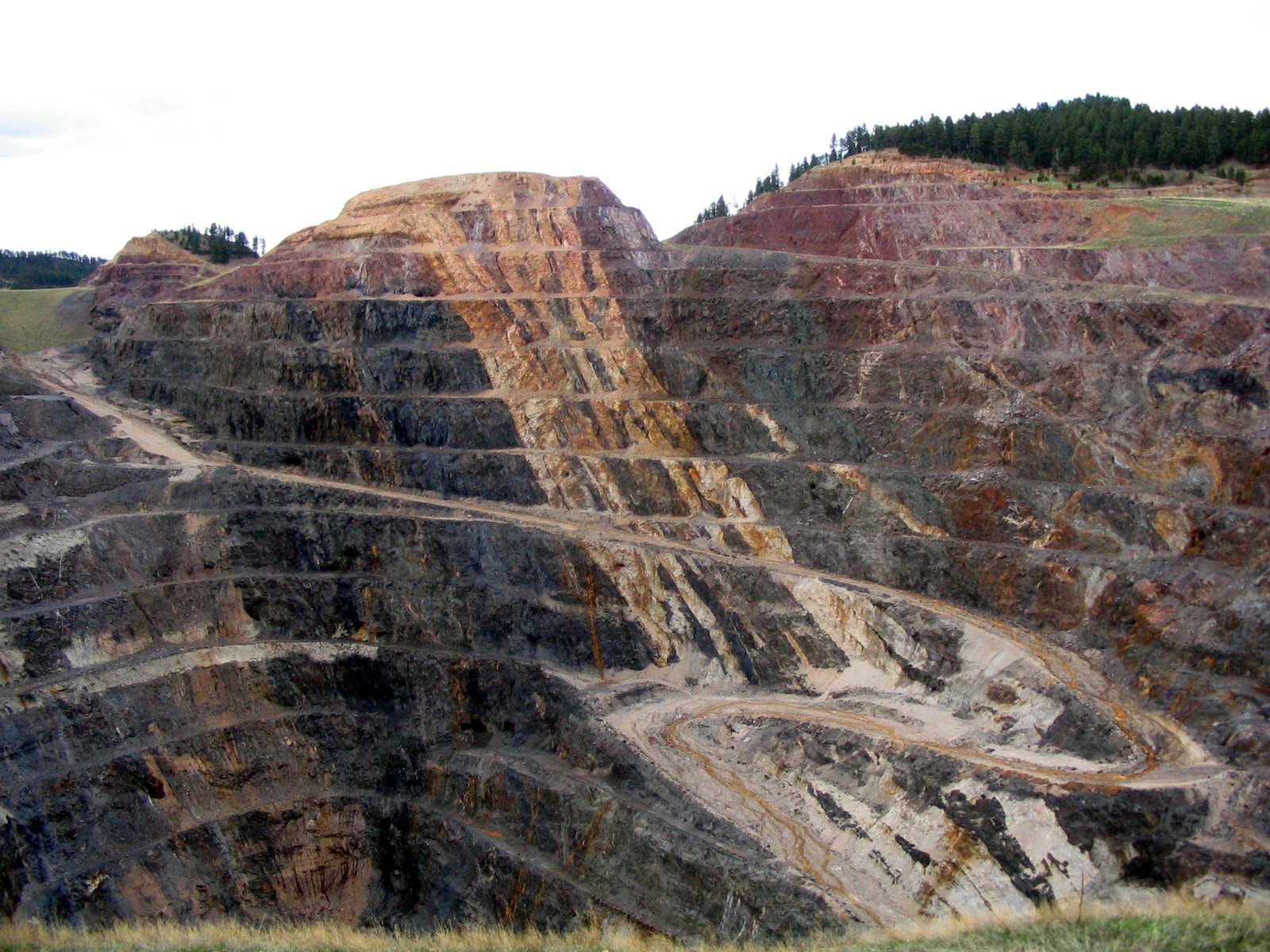|
Lode
In geology, a lode is a deposit of metalliferous ore that fills or is embedded in a fissure (or crack) in a rock formation or a vein of ore that is deposited or embedded between layers of rock. The current meaning (ore vein) dates from the 17th century, being an expansion of an earlier sense of a "channel, watercourse" in late Middle English, which in turn is from the 11th-century meaning of ''lode'' as a ‘course, way’. The generally accepted hydrothermal model of lode deposition posits that metals dissolved in hydrothermal solutions (hot spring fluids) deposit the gold or other metallic minerals inside the fissures in the pre-existing rocks. Lode deposits are distinguished primarily from placer deposits, where the ore has been eroded out from its original depositional environment and redeposited by sedimentation. A third process for ore deposition is as an evaporite. A stringer lode is one in which the rock is so permeated by small veinlets that rather than mining th ... [...More Info...] [...Related Items...] OR: [Wikipedia] [Google] [Baidu] |
Lodestone
Lodestones are naturally magnetized pieces of the mineral magnetite. They are naturally occurring magnets, which can attract iron. The property of magnetism was first discovered in antiquity through lodestones. Pieces of lodestone, suspended so they could turn, were the first magnetic compasses, and their importance to early navigation is indicated by the name ''lodestone'', which in Middle English means "course stone" or "leading stone", from the now-obsolete meaning of '' lode'' as "journey, way". Lodestone is one of only a very few minerals that is found naturally magnetized. Magnetite is black or brownish-black, with a metallic luster, a Mohs hardness of 5.5–6.5 and a black streak. Origin The process by which lodestone is created has long been an open question in geology. Only a small amount of the magnetite on the Earth is found magnetized as lodestone. Ordinary magnetite is attracted to a magnetic field like iron and steel is, but does not tend to become magn ... [...More Info...] [...Related Items...] OR: [Wikipedia] [Google] [Baidu] |
General Mining Act Of 1872
The General Mining Act of 1872 is a United States federal law that authorizes and governs prospecting and mining for economic minerals, such as gold, platinum, and silver, on federal public lands. This law, approved on May 10, 1872, codified the informal system of acquiring and protecting mining claims on public land, formed by prospectors in California and Nevada from the late 1840s through the 1860s, such as during the California Gold Rush. All citizens of the United States of America 18 years or older have the right under the 1872 mining law to locate a lode (hard rock) or placer (gravel) mining claim on federal lands open to mineral entry. These claims may be located once a discovery of a locatable mineral is made. Locatable minerals include but are not limited to platinum, gold, silver, copper, lead, zinc, uranium and tungsten. Western miners' codes Miners and prospectors in the California Gold Rush of 1849 found themselves in a legal vacuum. Although the US federal gover ... [...More Info...] [...Related Items...] OR: [Wikipedia] [Google] [Baidu] |
Comstock Lode
The Comstock Lode is a lode of silver ore located under the eastern slope of Mount Davidson, a peak in the Virginia Range in Virginia City, Nevada (then western Utah Territory), which was the first major discovery of silver ore in the United States and named after American miner Henry Comstock. After the discovery was made public in 1859, it sparked a silver rush of prospectors to the area, scrambling to stake their claims. The discovery caused considerable excitement in California and throughout the United States, the greatest since the California Gold Rush in 1849. Mining camps soon thrived in the vicinity, which became bustling commercial centers, including Virginia City and Gold Hill. The Comstock Lode is notable not just for the immense fortunes it generated and the large role those fortunes had in the growth of Nevada and San Francisco, but also for the advances in mining technology that it spurred, such as square set timbering and the Washoe process for extractin ... [...More Info...] [...Related Items...] OR: [Wikipedia] [Google] [Baidu] |
Ore Genesis
Various theories of ore genesis explain how the various types of mineral deposits form within Earth's crust. Ore-genesis theories vary depending on the mineral or commodity examined. Ore-genesis theories generally involve three components: source, transport or conduit, and trap. (This also applies to the petroleum industry: petroleum geologists originated this analysis.) *''Source'' is required because metal must come from somewhere, and be liberated by some process. *''Transport'' is required first to move the metal-bearing fluids or solid minerals into their current position, and refers to the act of physically moving the metal, as well as to chemical or physical phenomena which encourage movement. *''Trapping'' is required to concentrate the metal via some physical, chemical, or geological mechanism into a concentration which forms mineable ore. The biggest deposits form when the source is large, the transport mechanism is efficient, and the trap is active and ready at the ... [...More Info...] [...Related Items...] OR: [Wikipedia] [Google] [Baidu] |
Vein (geology)
In geology, a vein is a distinct sheetlike body of crystallized minerals within a rock. Veins form when mineral constituents carried by an aqueous solution within the rock mass are deposited through precipitation. The hydraulic flow involved is usually due to hydrothermal circulation. Veins are classically thought of as being the ones in the body not the rock veins and arteries planar fractures in rocks, with the crystal growth occurring normal to the walls of the cavity, and the crystal protruding into open space. This certainly is the method for the formation of some veins. However, it is rare in geology for significant open space to remain open in large volumes of rock, especially several kilometers below the surface. Thus, there are two main mechanisms considered likely for the formation of veins: ''open-space filling'' and ''crack-seal growth''. Open space filling Open space filling is the hallmark of epithermal vein systems, such as a stockwork, in greisens ... [...More Info...] [...Related Items...] OR: [Wikipedia] [Google] [Baidu] |
Binger Hermann
Binger Hermann (February 19, 1843 – April 15, 1926) was an American attorney and politician in Oregon. A native of Maryland, he immigrated to the Oregon Territory with his parents as part of the Baltimore Colony. Hermann would serve in both houses of the Oregon Legislative Assembly and as a Republican in the United States Congress. Hermann served as the Commissioner of the General Land Office for a period of about five years. His written directives known as the Binger Hermann Policy, caused mineral claimants of several lode mining claims (Ex: Lucky Strike Gold Mining Co.) to suffer from what is referred to as "cadastral mayhem" Many locators looking for a cure had to wait until August 8, 1904, when Paragraph 147 of the Mining Circular was revised under the authority of the Act of April 28, 1904. In 1904, Herman was also caught up in the Oregon land fraud scandal and brought to trial for alleged land fraud. The jury failed to agree and Hermann was never retried. Hermann w ... [...More Info...] [...Related Items...] OR: [Wikipedia] [Google] [Baidu] |
Ore Deposits
Ore is natural rock or sediment that contains one or more valuable minerals, typically containing metals, that can be mined, treated and sold at a profit.Encyclopædia Britannica. "Ore". Encyclopædia Britannica Online. Retrieved 7 April 2021Neuendorf, K.K.E., Mehl, J.P., Jr., and Jackson, J.A., eds., 2011, Glossary of Geology: American Geological Institute, 799 p. Ore is extracted from the earth through mining and treated or refined, often via smelting, to extract the valuable metals or minerals. The ''grade'' of ore refers to the concentration of the desired material it contains. The value of the metals or minerals a rock contains must be weighed against the cost of extraction to determine whether it is of sufficiently high grade to be worth mining, and is therefore considered an ore. Minerals of interest are generally oxides, sulfides, silicates, or native metals such as copper or gold. Ores must be processed to extract the elements of interest from the waste rock. Or ... [...More Info...] [...Related Items...] OR: [Wikipedia] [Google] [Baidu] |
Mineralization (geology)
In geology, mineralization is the deposition of economically important metals in the formation of ore bodies or "lodes" by various process. The first scientific studies of this process took place in the English county of Cornwall by J.W.Henwood FRS and later by R.W. Fox, FRS.Embrey, P. G. and Symes, R. F. ''Minerals of Cornwall and Devon'', London, British Museum of Natural History, 1987. hardback, 0-565-00989-3 paperback. page 14, and bibliography Fox: 135, Henwood: 137/8 The term can also refer to the process by which waterborne minerals, such as calcium carbonate (calcite), iron oxide (hematite or limonite) or silica (quartz), replace organic material within the body of an organism that has died and was buried by sediments. Mineralization may also refer to the product resulting from the process of mineralization. For example, mineralization (the process) may introduce metals (such as iron) into a rock. That rock may then be referred to as possessing iron mineralization. ... [...More Info...] [...Related Items...] OR: [Wikipedia] [Google] [Baidu] |
Thickness (geology)
Thickness in geology and mining refers to the distance across a packet of rock, whether it be a facies, stratum, bed, seam, lode etc. Thickness is measured at right angles to the surface of the seam or bed and thus independently of its spatial orientation. The concept of thickness came originally from mining language, where it was used mainly to indicate the workability of seams. It has since become an established term in earth science, for example in geology, for the depth of sedimentary rocks, in hydrogeology for the vertical extent of groundwater – i.e. the distance from the base of the groundwater layer to its surface – or in soil science for the vertical extent of soil horizon A soil horizon is a layer parallel to the soil surface whose physical, chemical and biological characteristics differ from the layers above and beneath. Horizons are defined in many cases by obvious physical features, mainly colour and texture. ...s. Literature * Walter Bischoff, Heinz Bram ... [...More Info...] [...Related Items...] OR: [Wikipedia] [Google] [Baidu] |
Homestake Mine (South Dakota)
The Homestake Mine was a deep underground gold mine (8,000 feet or 2,438 m) located in Lead, South Dakota. Until it closed in 2002 it was the largest and deepest gold mine in North America. The mine produced more than of gold during its lifetime. This is about or a volume of gold roughly equal to 18,677 US gallons. The Homestake Mine is famous in scientific circles because of the work of a deep underground laboratory that was established there in the mid-1960s. This was the site where the solar neutrino problem was first discovered, in what is known as the Homestake Experiment. Raymond Davis Jr. conducted this experiment in the mid-1960s, which was the first to observe solar neutrinos. On July 10, 2007, the mine was selected by the National Science Foundation as the location for the Deep Underground Science and Engineering Laboratory (DUSEL). It won over several candidates, including the Henderson Mine near Empire, Colorado. History The Homestake deposit was discovered ... [...More Info...] [...Related Items...] OR: [Wikipedia] [Google] [Baidu] |
Geographic Information System
A geographic information system (GIS) is a type of database containing geographic data (that is, descriptions of phenomena for which location is relevant), combined with software tools for managing, analyzing, and visualizing those data. In a broader sense, one may consider such a system to also include human users and support staff, procedures and workflows, body of knowledge of relevant concepts and methods, and institutional organizations. The uncounted plural, ''geographic information systems'', also abbreviated GIS, is the most common term for the industry and profession concerned with these systems. It is roughly synonymous with geoinformatics and part of the broader geospatial field, which also includes GPS, remote sensing, etc. Geographic information science, the academic discipline that studies these systems and their underlying geographic principles, may also be abbreviated as GIS, but the unambiguous GIScience is more common. GIScience is often considered a sub ... [...More Info...] [...Related Items...] OR: [Wikipedia] [Google] [Baidu] |









